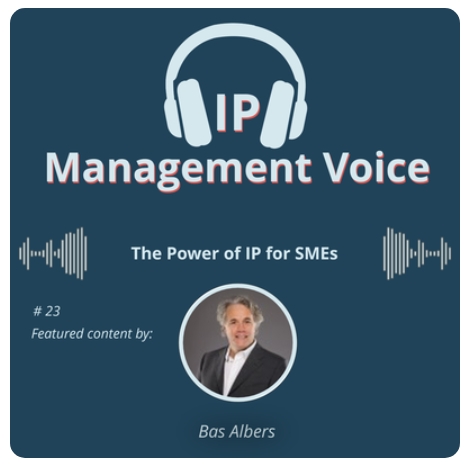The Power of IP for SMEs: Turning Intangible Assets into Real Advantage
When you think of IP, you might picture large corporations with expansive legal departments managing massive patent portfolios. But in Episode #23 of IP Management Voice, Bass Albers, IP strategist and advocate for SMEs, reminds us that IP isn’t just a legal issue—it’s a strategic resource. In his talk to CEIPI master’s students, he outlines a framework that shows small and medium-sized enterprises how to treat IP as a business enabler. His message is clear: IP is not just about protection—it’s about value creation.
IP as a Strategic Tool, Not Just Legal Protection
Albers challenges the conventional view that IP is primarily about preventing theft. Instead, he positions IP as a tool for building competitive advantage. In today’s fast-moving, innovation-driven economy, SMEs can’t afford to ignore IP. Whether it’s a unique process, a product design, a data algorithm, or even a brand name—these intangible assets are what differentiate businesses. The key is to recognize them as such and act early to protect and use them strategically.
He introduces the concept of an IP portfolio as a toolbox, where each tool—patents, trademarks, copyrights, and trade secrets—serves a distinct purpose. Rather than relying on a single form of protection, businesses should develop a comprehensive, customized IP strategy based on their goals and the realities of their market.
Here you find Bas Albers perspective on IP for SME at the digital IP lexicon 🔗dIPlex
Start with Identification: What Makes Your Business Special?
The first step, according to Albers, is surprisingly simple but often overlooked: take inventory of what makes your business unique. Many SMEs operate for years without realizing they possess valuable IP. It might be a novel method for organizing client data, a proprietary algorithm, or a slogan that customers associate with trust.
By pausing to map out their intellectual assets, business owners can identify what Albers calls their “crown jewels.” Without this awareness, those assets are vulnerable—both to competitors and to being overlooked in strategic planning. Identification is the foundation upon which the entire IP strategy rests.
Protection: Choosing the Right Tools for the Job
Once IP assets have been identified, the next step is selecting the appropriate form of protection. Albers breaks this down:
- Patents cover inventions—technical solutions to specific problems. While powerful, they are resource-intensive and suited for novel, innovative ideas.
- Trademarks safeguard brand identity, such as names, logos, and slogans. These build recognition and prevent confusion in the market.
- Copyrights protect creative works: software code, written content, videos, and more.
- Trade secrets involve confidential information that gives a business a competitive edge—like formulas, internal processes, or pricing algorithms.
Choosing the right combination depends on the nature of the asset and the strategic goals of the business. Sometimes it may be best to protect a method as a trade secret rather than filing a patent. In other cases, copyright and trademark might work together to protect a branded digital experience.
Align IP with Business Strategy
Crucially, Albers insists that IP strategy should not be developed in isolation. It must be integrated with the company’s overall business goals. Are you aiming to license your technology? Expand into new markets? Build a distinctive brand identity? Your IP approach should mirror these ambitions.
He advises SMEs to consider the competitive landscape. Who are your main competitors? What types of IP are they prioritizing? Are there gaps in their strategy you could exploit—such as neglected trademarks or overlooked domains? Strategic positioning in IP can reveal hidden opportunities and minimize risk.
Build a Culture of IP Awareness
One of the most powerful parts of Albers’ framework is his emphasis on internal awareness. For IP to work, it has to be more than just a file on a lawyer’s desk—it must be embedded in the culture of the organization.
He encourages SMEs to involve all departments in the IP process. From engineering to marketing, every team member plays a role. Albers suggests introducing IP awareness training during onboarding, creating clear internal policies for handling confidential information, and making sure employees know how and when to report new ideas or inventions.
Creating a culture of awareness doesn’t require turning every employee into an IP expert. Rather, it’s about ensuring they understand the value of intangible assets and their role in protecting them.
Use Technology to Simplify IP Management
Managing IP doesn’t have to be complex or expensive. Albers highlights a range of affordable tools that SMEs can use to organize and maintain their IP portfolios. These include:
- Cloud-based systems for storing confidential files
- Trademark search engines for vetting new product names
- IP management software to track deadlines and renewals
- AI-based platforms to help identify potentially patentable inventions
The idea is not to create bureaucracy, but to make the process practical and sustainable. With the right digital infrastructure, even a small team can efficiently manage a growing portfolio of assets.
Find here the entry on IP Management in the🔎IP Management Glossary
Design Clear Internal Processes
Another cornerstone of successful IP strategy is good process design. Albers explains that it’s not enough to simply recognize and protect IP—you also need systems in place to manage it over time. For example:
- Define how employees submit invention disclosures
- Establish approval workflows for marketing materials that include brand assets
- Document access protocols for trade secrets
- Schedule regular portfolio reviews
Even basic tools like checklists or flowcharts can go a long way toward making IP processes clear and repeatable. As the business grows, these systems can be scaled up, but the key is to start with structure from the beginning.
Find here the digital IP lexicon 🔗dIPlex deep dive on IP and Organization
Focus on Implementation and Performance
Albers emphasizes that strategy is only as good as its execution. He advocates for a performance-based approach, where IP is not only identified and protected, but also tracked and measured over time. Are your protected assets being used effectively? Are they generating value? Could they be licensed, repurposed, or monetized in new ways?
This requires regular review and adaptation. Markets shift, technology evolves, and what worked a year ago may not be competitive today. Successful SMEs treat their IP strategy as a living framework—something to be actively managed, not archived.
Tap Into External Expertise When Needed
Recognizing that most SMEs don’t have in-house legal teams, Albers encourages leaders to seek help when needed. Whether it’s from IP attorneys, consultants, or public support services, external expertise can accelerate the process and prevent costly missteps. He also points to government resources, nonprofit programs, and industry networks that provide education and support tailored for SMEs.
Even limited engagement—such as having a lawyer review your strategy once a year or helping draft standard NDAs—can make a big difference in minimizing risk and maximizing protection.
Stay Agile and Future-Focused
Perhaps the most important message Albers shares is about agility. The world of IP is constantly evolving. Digital transformation, AI, and global competition mean that yesterday’s strategy won’t work tomorrow. Businesses must stay alert and be willing to revise their IP approach as the landscape changes.
This mindset applies not only to the assets themselves but also to how IP interacts with other business functions—from marketing and product development to HR and IT. IP should not be a silo—it should be woven into the fabric of business decision-making.
Find here the entry on Agile Organization in the🔎IP Management Glossary
IP as an Asset, Not a Burden
Throughout his talk, Albers returns to one central idea: IP is not a burden. It is not just legal paperwork or regulatory hassle. Done right, it’s an asset—something that adds real, tangible value to the business. It strengthens your position, clarifies your identity, attracts investors, and opens doors for licensing, partnerships, and expansion.
When approached strategically, IP becomes a growth enabler. And for SMEs, who must compete without the scale advantages of large firms, that can be a game-changer.
A Call to Action for SMEs
So what should SMEs take away from Albers’ approach?
- Start with awareness. Know what you’ve created and what sets you apart.
- Get organized. Build simple, repeatable systems to manage your assets.
- Link IP to strategy. Make sure your protection efforts support your business goals.
- Involve your team. Encourage ownership and awareness across the organization.
- Use technology wisely. Even small tools can simplify complex processes.
- Seek help when needed. You don’t need to be an IP expert to act like one.
In a world where innovation moves fast, those who wait risk losing their edge. But those who act—who build a culture of IP management and see it as a strategic resource—will be better positioned to thrive.
 Final Thought
Final Thought
Bass Albers offers a roadmap that’s not only pragmatic but empowering. For SMEs, the message is clear: you don’t need a giant legal budget to start managing your IP like a pro. What you need is awareness, intention, and a willingness to act. That’s the power of IP—not just to protect, but to build, grow, and compete.
🎧 Listen to Episode #23 of IP Management Voice to hear Albers’ full perspective and explore how your own business can put these ideas into practice.



